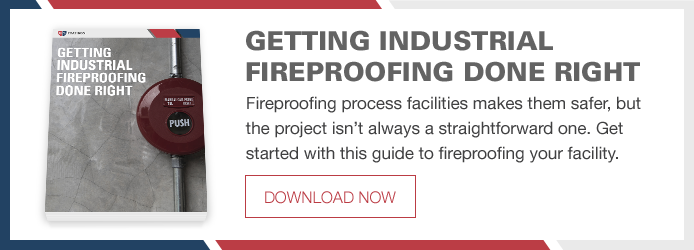Getting Started with Intumescent Paint Specifications
General paint specifications vs. intumescent fireproofing specifications
Following a call with an insurance firm or a company auditor, many owners simply don’t know where to turn to put a fireproofing plan in motion. As with writing any type of paint specifications, they tend to turn to one of three sources: an engineering firm, a trusted contractor or a supplier of fireproofing coatings.
Unlike with general paint specifications, fireproofing projects are highly specialized and it’s important that an owner fall back on an individual or firm with extensive experience with similar projects. If engineering firms have an in-house fireproofing expert, they can be a valuable resource in devising a plan. If not, a customer may wind up paying an engineer to outsource a job, a step that could undoubtedly be skipped to reduce costs. The same holds true for applicators. If they are unfamiliar with the products on the market, or even how they’re best applied, they will likely need to seek outside advice themselves.
In the end, a industrial coatings supplier will likely have the best understanding of the fireproofing products they supply. For US Coatings, that means having an in-depth understanding of Albi fireproofing paint specifications, the fireproofing product we carry. Experience should once again be a factor. If a supplier only recently began carrying a fireproofing product, and has little idea of how they behave, best practices for application and no suggestions for preferred contractors, it may be best to continue shopping for an expert with more experience that still remains within the project’s budget.
Regardless of which path is pursued, owners should expect a few things from an initial facility audit. It should come with detailed notes and photographs explaining the fireproofing measures to be undertaken in each section of the facility and why. It should include budgetary projections so that owners know what they’re paying for at each stage of the project. It’s also helpful if the expert is able to offer recommendations on applicators that have performed good work in the past and have experience with fireproofing facilities; this is where a strong working knowledge of intumescent paint specifications is essential.
The best reports following an initial audit will provide an owner with the peace of mind that comes from knowing how to proceed. Though a steel fireproofing project may have been mandated from an outside source, this document should alleviate any panic that comes from not knowing how to move forward.
Intumescent paint specification experts
US Coatings is a supplier of a full line of Albi fireproofing products. Easy application of these single-component products makes them less expensive to apply, typically closing any gap in cost between an intumescent solution and a lightweight cementitious one.
We also have the in-house fireproofing expertise. Full facility audits provide owners with all the knowledge they need to move forward with a fireproofing project with confidence. It’s part of our promise to be more than just a paint and coatings supplier.
So whether industrial fireproofing is an unexpected project that needs to be dealt with immediately, or a facility safety measure that’s been put off for far too long, we’d be happy to be your first step. Follow this link and get in touch with US Coatings today.
Want to learn more about fireproofing? Download the guide below for our full guide to fireproofing your assets.





